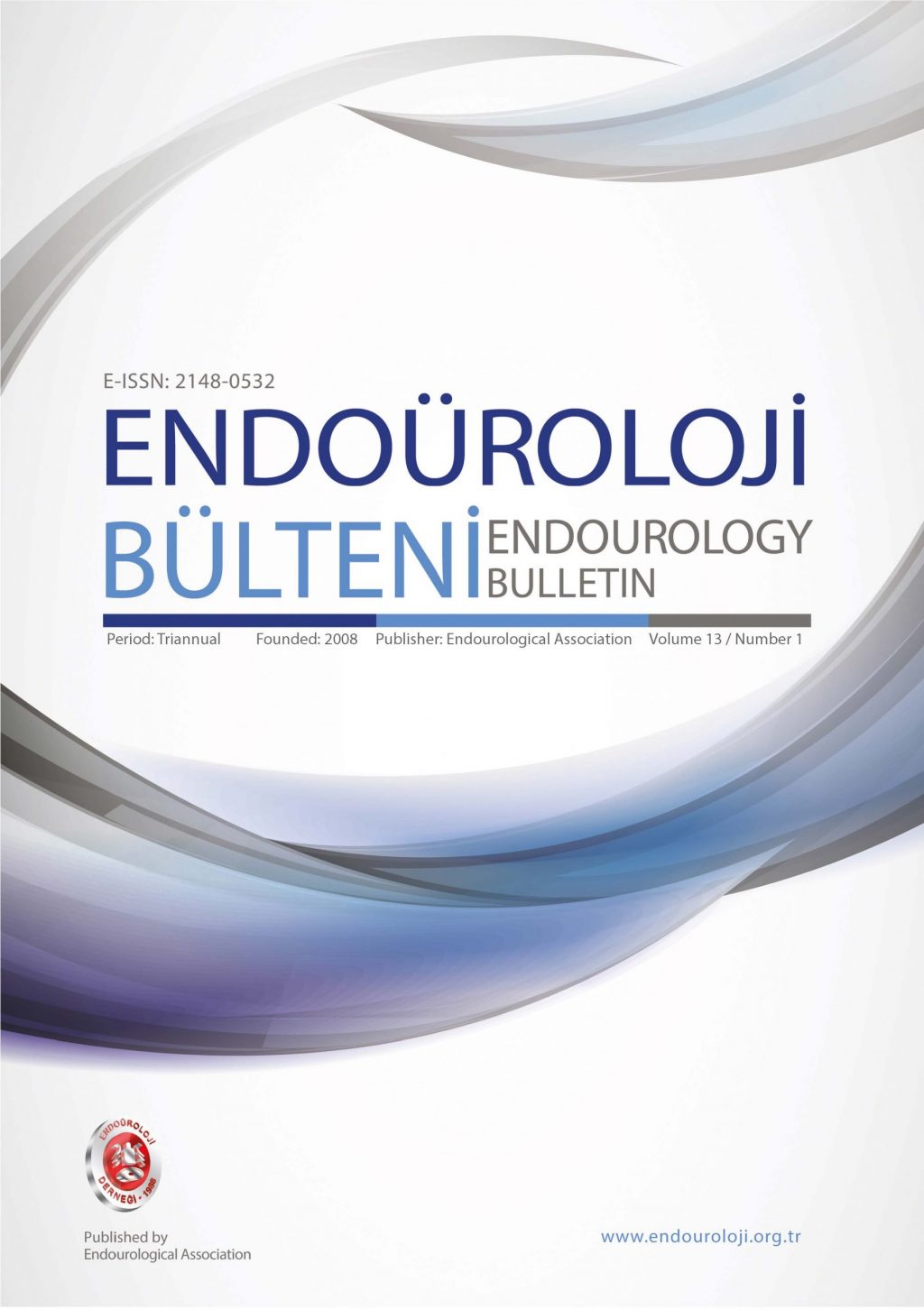
Editorial Board Message
Prof. Dr. Selçuk GÜVEN
Editorial Borad
Arbitrators List
Contents
Original Article
Evaluation of success and complications using the Guy’s stone score and modified Clavien rating system in percutaneous nephrolithotomy
Doğukan Sökmen, Yusuf İlker Çömez, Volkan Tuğcu
Abstracts
Objective: Urinary system stone disease has been one of the leading diseases that negatively affect human life and quality of life throughout history. Our aim is to present the percutaneous nephrolithotomy experience of three centers in our country in all aspects (patient selection, success, additional treatment requirement, complications, mortality) and to shed light on future studies.
Material And Methods: Classical PNL and miniPNL with full records; The data of 944 patients from 3 centers were evaluated retrospectively. Kidney stones were classified using the Guy Stone Scoring system (Guy’s Stone Score, GSS) based on stone burden and localization. Clavien classification, modified by them in 2004, was used for per-operative and post-operative complications in patients. In statistical analysis; success, the need for additional treatment, the effect of complications on complications and percentage rates were compared using the chi-square test, and p <0.05 was considered statistically significant. Independent factors affecting success, complications, and additional treatment were determined using logistic regression analysis.
Results: In 662 of our 944 patients (70.13%), success was achieved in direct urinary system radiography and / or non-contrast abdominal CT taken on the first postoperative day without any rest stones. After additional treatment applied to 23.30% of the patients, this rate increased to 83.65% in the postoperative 6th month. The success rate for stones in the GSS 1 group was 90.06% and was quite high. This ratio was statistically significant compared to the GSS 3 and GSS 4 groups (p <0.001). The success rate increases significantly in groups with low GSS scores. A total of 478 complications were observed in 435 (46.08%) of 944 patients operated on. When we arrange these data according to the modified Clavien grading system, 159 (16.84%) in grade 1, 152 (16.10%) in grade 2, 113 (11.97%) in grade 3a, 15 in grade 3b ( 1.58%), 9 (0.95%) in grade 4a, 1 (0.10%) in grade 4b, and 1 (0.10%) in grade 5 were observed. When the distribution of complications by stone groups was examined, it was observed that all grade 4a, 4b, and grade 5 complications were seen in GSS 4 group stones.
Conclusion: The complex classification of kidney stones can be eliminated using the “Guy Stone Score”. It is categorized in a simple way and the probabilities of success and complications are predicted. Complications can be standardized using the “Modified Clavien Grading”. In addition, the classifications shed light on clinical research and studies.
Keywords: Kidney stones, GSS, Clavien, percutaneous nephrolithotomy, complications, stone-free
Original Article
Urosepsis after endoscopic urinary system stone treatment: factors increasing risk
Dilek Bulut, Merve Sefa Sayar, Ender Cem Bulut, Alper Bitkin, Fatih Bıçaklıoğlu, Serhat Çetin, Murat Yavuz Koparal, Kasım Ertaş
Abstracts
Objective: Urinary system stones are an increasingly common disease that creates serious financial burden on the health system. Urinary infections are substantial after endoscopic treatment of urolithiasis with ureterorenoscopy (rigid or flexible). In this study, we examined the incidence of urosepsis in patients applied endoscopic stone treatment with ureterorenoscopy and the factors that increase it. Thus, we aimed to contribute to the discussion on measures to be taken to prevent urosepsis in patients.
Material And Methods: Patients who underwent endoscopic stone treatment with ureterorenoscopy for kidney or ureteral stones were included in the study. The two groups, which were divided into those with and without urosepsis, were compared with each other in terms of age, gender, comorbidity, and residual stones.
Results: The total number of patients included in the study was 561. The median age of the patients included in the study was 39 (18-77). Sepsis findings were observed in 12 (4.2%), 31 (14.2%) and 9 (16.7%) patients, respectively, in patients grouped according to the age range of 18-40, 41-60 and 61-80 years. There was a significant difference between these groups in terms of the incidence of urosepsis (p <0.001). While 39 (25.3%) patients had urosepsis in the patient group with comorbidity, 13 (3.2%) patients had urosepsis in the patient group without comorbidity. A statistically significant difference was found between the two groups in terms of the rates of urosepsis (p <0.001).
Conclusion: Recognizing the factors that facilitate postoperative urosepsis is important for effective prophylaxis and effective antibiotherapy in treatment. Findings to be obtained with high patient numbers may decrease the cost and morbidity rates created by urosepsis.
Keywords: urosepsis, endourology, antibiotherapy, urolithiasis
Original Article
Mini percutaneus nephrolithotomy: the contrubition of the new system to our practice
Yusuf İlker Çömez, Doğukan Sökmen
Abstracts
Objective: In this study, the evaluation of the patients who were operated with Minimal Invasive Percutaneus Nephrolithotomy (MIP) approach is aimed.
Material And Methods: The data of consecutive 50 mPNL patients between January 2016- January 2017
were obtained and retrospectively evaluated. All patients were evaluated in terms of anesthesiology risks,
patient positions, access locations, stone sizes, stone clearence rates, postoperative drainage requirement
and complications.
Results: All patients have undergone mPNL procedures. Mean stone size was 20 (12-33) mm and mean
stone number was 1 (1-3). Mean stone clearence rate was 98% (97-100). Complication rate was 6% while
transfusion necessity was 2%.
Conclusion: mPNL with MIP system, with its low complication rate, easy access to all calyceal systems and
advantages of different patient posisitons, may be a good alternative to cPNL, even to ureterorenoscopy
and ESWL.
Keywords: Mini-PNL, PNL, Percutaneous nephrolithotomy, MIP, Minimally invasive
Original Article
Our experience of retrograde intrarenal surgery in the treatment of upper urinary tract stones
Yasin Yitgin, Ayhan Karaköse, Ekrem Akdeniz
Abstracts
Objective: The purpose of this study was to evaluate results for patients with renal or proximal ureter stone
disease and undergoing retrograde intrarenal surgery (RIRS).
Material And Methods: Demographic, clinical, operative and postoperative datas from 99 patients who
underwent RIRS for upper urinary tract stones between March 2019 and May 2020 were analyzed retrospectively. Non-contrast computed tomography (CT) was routinely performed on all patients. Stone location and size were assessed using CT. Achieving stone-free status or residual stone size ≤ 2 mm were
regarded as operational success.
Results: RIRS was performed on 99 patients, 60 (60.6%) men and 39 (39.4%) women, with a mean age of
44.9 ± 13.1 years. RIRS was applied to the right unit in 48 patients and to the left in 50. The procedure was
performed on both sides in the same session in one case. The stone was in the kidney in 78 patients and
in the proximal ureter in 21. The mean stone burden was 18.5 ± 6.9 mm, and the mean operative time was
70.6 ± 23.8 minutes. All patients were discharged on the first postoperative day. No complications occurred
during surgery or the postoperative period. The stone free rate was 90.9%.
Conclusion: We believe that the RIRS procedure is a minimally invasive technique that can be used instead
of percutaneous nephrolithotomy as experience increases and technology advances.
Keywords: Flexible ureterorenoscopy, retrograde intrarenal surgery, upper urinary tract stone
Case Report
Bladder cancer and genetic backround in young patients
Ali Erhan Eren, Selim Taş
Abstracts
Although bladder cancer can be seen at any age, it is rarely seen in young patients. Patients often present
with the complaint of painless clotted hematuria. Although there is no exact age range for young patients
in the literature, published papers have defined classifications as under 20 years old, between 20 and 40
years old and over 40 years old. The PI3K pathway and the associated PIK3CA gene are located on chromosome 9.
In this case report, we aimed to present a young patient with PIK3CA gene mutation that has unclear effects on bladder cancer. A 22-year-old male patient applied to center. Ultrasonography showed a 6×4 cm
papillary mass near the base of the left lateral wall of the bladder. Subsequently, transurethral resection
was performed. Histopathological examination established the diagnosis of superficial low-grade papillary
urothelial carcinoma (pTa Low-Grade) based on the WHO/ISUP 2004 classification.
It was concluded that the PIK3CA gene mutation in this case may be related to bladder cancer.
Keywords: bladder cancer, genetic background, young patıents


